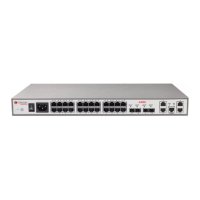A10E/A28E/A28F Configuration Guide
The OAM link monitoring is used to detect and report link errors in different conditions.
When detecting a fault on a link, the A10E/A28E provides the peer with the generated
time, window and threshold setting, etc. by OAM event notification packets. The peer
receives event notification and reports it to the NMS center via SNMP Trap. Besides,
the local device can directly report events to the NMS center via SNMP Trap.
By default, the system sets default value for error generated time, window and
threshold setting.
(Optional) configuring OAM fault indication
Enter global configuration mode.
Alpha-
A28E(config)#interface
port
port-id
Enter physical layer interface configuration
mode.
Alpha-A28E(config-
port)#oam notify
{ critical-event | dying-
gasp | errored-frame |
errored-frame-period |
errored-frame-seconds |
errored-symbol-period }
{ disable | enable }
Configure OAM fault indication, which is
used to inform the peer when the local fails.
Faults that can be notified to the peer contain
link-fault, dying-gasp, and critical-event. By
default, OAM fault indication is enabled.
When a fault occurs, the local device notifies
the peer through OAM. The link-fault fault
must be notified to the peer while the dying-
gasp and critical-event faults can be disabled
by this command.
(Optional) configuring local OAM event alarm
Enter global configuration mode.
Alpha-
A28E(config)#interface
port
port-id
Enter physical layer interface configuration
mode.
Alpha-A28E(config-
port)#oam event trap
enable
Enable local OAM event alarm and then link
monitoring event can be reported to NMS
center in time.
8.1.7 Checking configurations
Use the following commands to check configuration results.
Alpha-A28E#show oam [ port-
list
port-list
]
Show EFM basic information.

